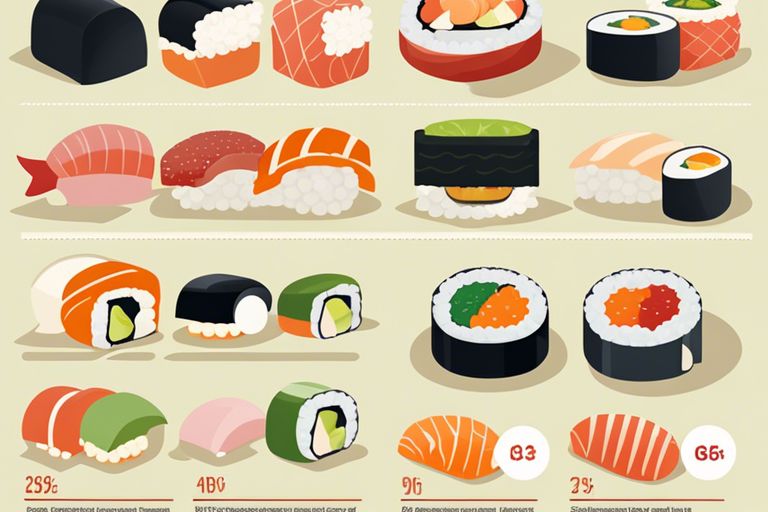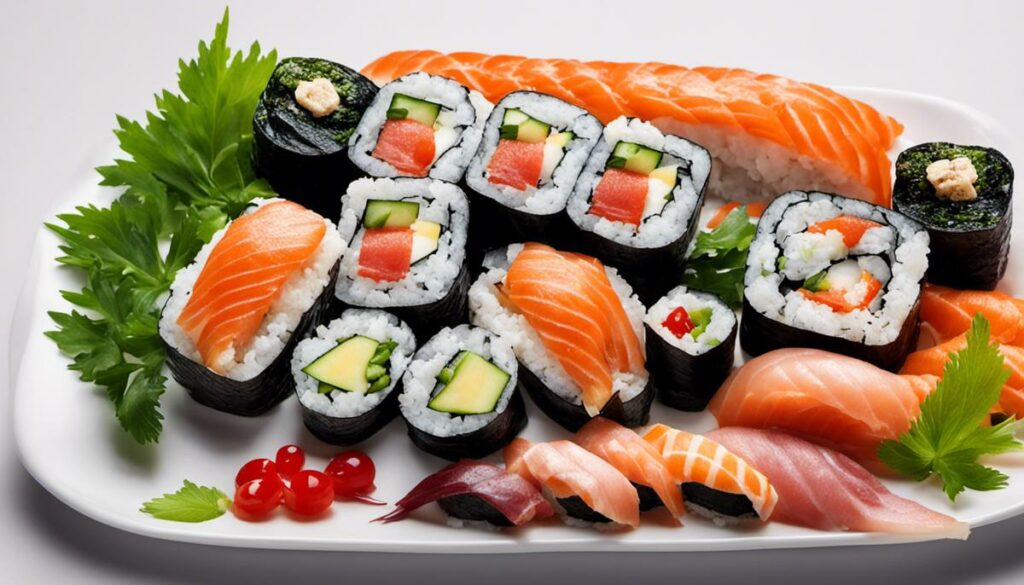Introduction
Welcome to my new blog post about allergies and sushi. In this post, I will cover different aspects of allergies in relation to enjoying sushi. Whether it’s cross-allergies, gluten-free options, or other allergic reactions, here’s everything you need to know to enjoy your sushi experience.
Allergies in general
Allergies are common and can vary greatly from person to person. Some people react to pollen, others to food, and still others to animal dander. It is important to know your own allergies and take appropriate precautions to avoid unpleasant reactions.
The connection to sushi
Various allergies can play a role in the consumption of sushi. For example, raw fish, soy sauce, or pickled ginger can trigger allergic reactions in some people. It is therefore important to be aware of how different ingredients in sushi can affect allergies in order to enjoy carefree.
Cross-allergies and sushi
What are cross-allergies?
Cross-allergies are reactions of the immune system to certain proteins found in various foods. These proteins are similar to those to which a person is already allergic. Therefore, if there is an allergy to certain foods, there may be cross-reactions when similar proteins are consumed in other foods.
It is important to note that cross-allergies do not occur in all individuals who suffer from a particular food allergy. However, they are an important aspect in terms of food choices and avoiding potentially problematic foods.
Common cross-reactions with sushi
In sushi, cross-reactions can occur, especially with different seafoods, as they contain similar proteins. For example, individuals who are allergic to shrimp may also experience a reaction to other crustaceans, such as crabs or lobsters. In addition, cross-allergies can also occur in certain types of fish, especially relatives such as salmon, trout or mackerel.
It is advisable to always point out possible cross-allergens when ordering sushi and ask about alternative options to avoid unpleasant reactions. It is also important to find out about the ingredients and allergens in the various sushi dishes in order to be able to enjoy the food safely.
Sushi – A World of Ingredients
Sushi is not only a delicious Japanese specialty, but also a world of diverse ingredients. From fresh fish and seafood to a colourful selection of vegetables and seaweed, the possibilities are endless. The ingredients play a central role in the preparation of sushi, especially for people with allergies or intolerances.
Fish and seafood – allergens under the microscope
For many sushi lovers, fish and seafood are the main attraction. But it is precisely here that allergens often lurk that can cause serious reactions. Caution is advised especially for allergy sufferers, because tuna, salmon, shrimp and other seafood can lead to serious allergic reactions. It is therefore advisable to find out about the fish and seafood it contains, as well as possible cross-allergies, before consuming sushi.
Vegetables, Algae and More – Hidden Allergens
In addition to fish and seafood, vegetables also play an important role in the world of sushi. From cucumbers and avocados to various types of seaweed such as nori and wakame, the selection of plant-based ingredients is diverse. But even here there are potential allergens hiding to which sensitive people can react. It is therefore advisable to find out about possible allergens in vegetables, seaweed and other ingredients in order to enjoy sushi without any worries.
When preparing sushi, it is important to cater to the individual needs and allergies of the guests. A precise knowledge of the ingredients and possible allergens is therefore essential to ensure that all guests can enjoy the sushi carefree.
Gluten-free sushi
If you have celiac disease or gluten intolerance, you may be wondering if you can still enjoy sushi. The good news is that it’s entirely possible to find gluten-free sushi or even make it at home. You just need to know the right alternatives and ingredients.
To learn more about gluten-free sushi, you can read the article “Is sushi gluten-free? | BeyondCeliac.org” read. There you will learn how to find out about the gluten-free options at different sushi restaurants and what to look for when preparing gluten-free sushi at home.
Risks of traditional sushi
There is a risk of cross-contamination with traditional sushi, as soy sauce and pickled ginger can often contain traces of gluten. In addition, breadcrumbs and other gluten-containing ingredients are often used in the preparation of sushi. People with gluten intolerance should therefore be wary of conventional sushi and look for gluten-free alternatives.
Gluten-free alternatives and ingredients
Luckily, there are plenty of gluten-free alternatives and ingredients you can use to make sushi. These include gluten-free soy sauce, nori seaweed sheets, sushi rice, and fresh seafood. You can also get creative and incorporate different vegetables and exotic fruits into your gluten-free sushi to create a unique taste experience.
To learn more about gluten-free alternatives and ingredients for sushi, you can contact your local health food store or specialized online stores that offer a variety of gluten-free products. With the right ingredients and a little experimentation, you can enjoy delicious gluten-free sushi that will tantalize your taste buds while supporting your health.
Safe enjoyment – tips for allergy sufferers
If you suffer from allergies, there are a few things you need to keep in mind when enjoying sushi in order to be able to feast carefree. Here are some tips to help you enjoy safely:
Eating out with allergies – What you should consider
Before visiting a sushi restaurant, find out about the allergy-friendly options. Call ahead and ask about the ingredients of the dishes. When ordering, clearly state your allergies and ask the chef to take extra care. Also, watch out for possible cross-contamination, especially if you suffer from severe allergies.
Making Sushi at Home – Ingredient Control
Making sushi at home gives you control over the ingredients and allows you to accommodate your individual needs. Use fresh ingredients and carefully check labels to ensure that all products are free of allergenic substances. So you can enjoy your own allergy-friendly sushi without hesitation.
If you suffer from gluten allergy, you can resort to gluten-free soy sauce and use alternative sushi rice to enjoy a safe yet delicious meal. By making it yourself, you have the peace of mind that there are no unwanted ingredients in your sushi.
Conclusion and Final Thoughts
Before we say goodbye to this topic, we would like to share a few final thoughts. Allergies and intolerances can make it difficult to eat sushi, but there are still plenty of ways to enjoy these tasty dishes. It’s important to be aware and attentive when it comes to allergies, and always ask for gluten-free options if needed. But the most important thing is to continue to appreciate the variety and joy of Japanese cuisine and not be discouraged by allergies.
FAQ
Q: What types of allergies can occur when eating sushi?
A: Allergies to seafood, fish, soy, sesame or other ingredients may occur when consuming sushi. Cross-allergies are also possible.
Q: Are there any gluten-free options for sushi lovers with celiac disease?
A: Yes, many Japanese restaurants now offer gluten-free soy sauce and sushi options that are suitable for people with celiac disease.
Q: How to avoid cross-allergies when eating sushi?
A: To avoid cross-allergies, it is important to find out about the ingredients used and, if necessary, to seek individual advice from an allergist.
Q: What alternatives are there for sushi lovers with a soy allergy?
A: For people with soy allergies, there is the option of using alternative sauces or marinades that do not contain soy ingredients.
Q: Are vegetarian or vegan sushi options available?
A: Yes, many sushi restaurants offer a variety of vegetarian and vegan sushi options that are made without fish or animal products.


